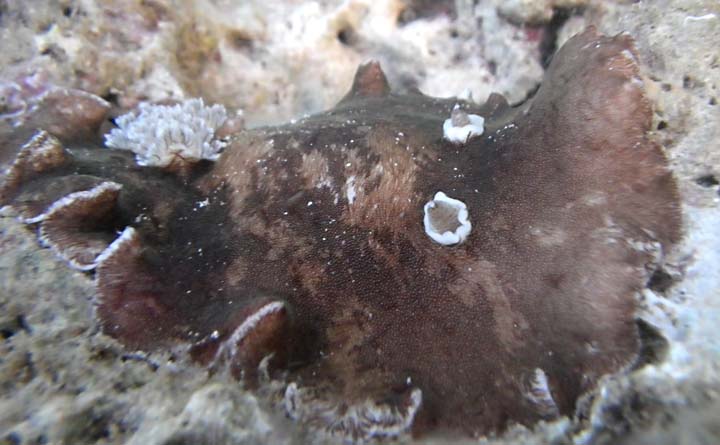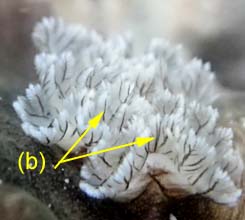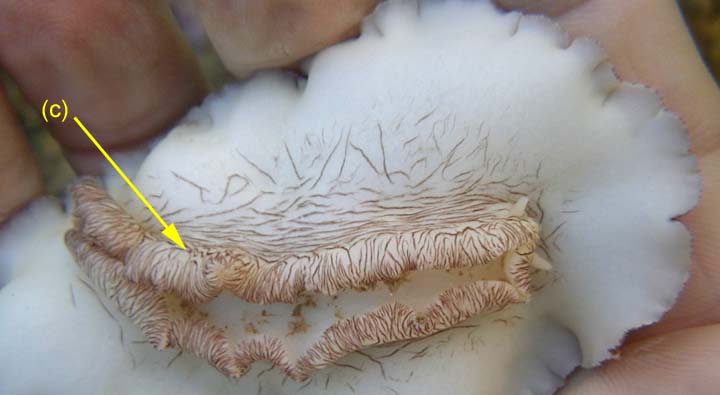This species has been observed on Reunion, Mayotte and Madagascar Islands
|
Species characteristics : The background colour of the living animals is white or cream. There are numerous short, thin, wavy brown lines on the dorsum. These lines normally cover the entire dorsum, but they may be absent from portions of the dorsum in some specimens. Brown lines varying in size and distribution are also present on the ventral side of some specimens, especially surrounding the foot |
 |
|
| Showing species characteristics... |
Photo Christophe
Cadet
Reunion, Etang salé on the rocky coast, less 1 m, 21 September 2009, size : 70 mm |
|
Remarks :
Identification confirmed by Angel Valdès
Like the specimen from Red Sea our specimens from South West of Indian Ocean haven't any large red spots on the dorsum.
Dorgan, K.M., A. Valdés & T.M. Gosliner. 2002 consider that P. cruenta ( Quoy & Gaimard, 1832 ) and P. striata (Kelaart, 1858) are regarded as synonyms.
Bill Rudman and Nathalie Yonow considered that they are probably two differents species... So they use for these specimens from Indian Ocean and Red Sea, without red blotches dorsally or ventrally on the mantle the name of Platydoris striata
Synonymous : (according Worms)
- Doris striata Kelaart, 1858
Bibliographic data :
This species, with P. formosa, P. scabra and P. cinerobranchia form a group of very similar species.
Remark : Dorgan, K.M., A. Valdés & T.M. Gosliner. 2002 consider that P. cruenta ( Quoy & Gaimard, 1832 ) and P. striata (Kelaart, 1858) are regarded as synonyms.
P. cruenta
P. striata
P.cinerobranchiata
Localisation
Tropical Indo-West Pacific
Tropical Indo-West Pacific
Tropical West Pacific
Tropical Indo-West Pacific
Solomon Islands
Mantle coloration
Brown spotted
with red patchesBrown spotted
without red patchesBrown lined
with red patches
Brown lined
without red patchesReddish, or orange patches and no brown specks or lines.
Rhinophore coloration
They are uniformly red, with the tips somewhat lighter
They are yellowish, often with darker orange tips.
They have a dark brown clavus with white flecks on the lamellae
They are dark red or brown
They are dark red or brown
Underside of the mantle and foot
The underside is white and has many large, bright orange red spots (not always easily visible). These spots are larger and densely concentrated near the foot, where some of them can be fused together
The underside of the mantle is dirty white and there are some brown speckles on the side of the foot.
The underside of the mantle is white with brown lines near the foot, and scattered red patches. The sole of the foot can also have brown lines
The underside of the mantle is white without red patches
The underside of the mantle is white with red patches
In some specimens there may be large red spots on the dorsum and on the ventral side, in some cases covering large portions of the body.
Both lines and red blotches varying in size and distribution are also present on the ventral side of some specimens, especially surrounding the foot
The body feels very firm because the skin is toughened with tiny rods ( the dorsum is entirely covered with small caryophyllidia ) and the mantle is extremely rough to the touch.
The rhinophoral and branchial sheaths are elevated.
The branchial sheath has six branchial lobes, with the anterior and posterior ones being larger than the others. The gill is composed of six tripinnate branchial leaves. There are irregular dark lines on the rachises of the gill lamellae. Branchial leaves are the same colour or darker than the dorsum and are also covered with brown lines
The perfoliate rhinophores always have 37 lamellae. Rhinophores leaves are the same colour or darker than the dorsum and are also covered with brown lines
Found on shallow reef flats where it is nocturnally active
References :
Bill Rudman Seaslug site : Sea Slug Forum : Platydoris cruenta and Platydoris striata
Nudipixel Platydoris cruenta
Publications :
Alder J. & Hancock A. (1864). Notice of a collection of nudibranchiate Mollusca made in India by Walter Elliot Esq. with descriptions of several new genera and species. Transactions of the Zoological Society of London 5 (3-4): 113-147
page(s): 118
Dorgan, K.M., A. Valdés & T.M. Gosliner. 2002. Phylogenetic systematics of the genus Platydoris (Mollusca, Nudibranchia, Doridoidea) with descriptions of six new species. Zoologica Scripta. 31(3): 271-319.
Kelaart, E.F. (1858). Description of new and little known species of Ceylon nudibranchiate molluscs and zoophytes. Journ. Roy. Asiatic Soc. Ceylon Branch, Colombo, 3 : 8-139, with 2 unnumbered plates
Quoy, J.R. & Gaimard, J.P. (1832). Voyages de découvertes de l`Astrolabe pendant les années 1826-1829 sous le commandement de M.J. Dumont d`Urville. Zoologie, 2 : 1-686.
Other photos of Platydoris striata :
 |
Philibert Bidgrain
There are numerous short, thin, wavy brown lines (a) on the dorsum.  |
|
Bown lines varying in size and distribution are also present on the ventral side of some specimens, especially surrounding the foot (c) There are irregular dark lines on the rachises (b) of the gill lamellae  |
 |
|
Florence Trentin Reunion, Les kiosques, Saint Leu, 10 m, 14 March 2007, size : 60-70 mm Two specimens crawling on the substrate, during a night dive. Specimens with small red blotches (a)  |
 |
 |
Alain Barrère Madagascar, April 2005 Specimens with little wavy lines on the body Two specimens with their spawn...
|
|
Hugues Flodrops Reunion, Etang Salé on the rocky coast, less 1 m, 31 January 2011, size : 75 mm The dorsum and the foot on the same photo... |
 |
More photos from Indian Ocean
Reunion, Platydoris striata with little wavy lines, at Etang Salé, by Christophe Cadet
Reunion, Platydoris striata with small red patches, at Saint Paul, by Fabrice Mallet
Reunion, rhinophore detail of Platydoris striata, at Saint Gilles, by Philippe Bourjon